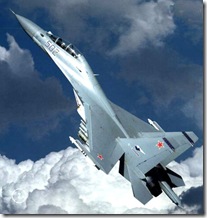Flanker aerodynamics: Irrelevant?
 Steve Trimble has an interesting interview with a LockMart test pilot who puts the awesome aerodynamic prowess often exhibited by the Sukhoi Flanker family into the context of actual WVR combat.
Steve Trimble has an interesting interview with a LockMart test pilot who puts the awesome aerodynamic prowess often exhibited by the Sukhoi Flanker family into the context of actual WVR combat.
Naturally, now that the (aerodynamically supreme) F-22 is practically a “dead” project and the market spotlight is on the F-35, LM goes to great lengths to argue that the JSF’s aerodynamic deficiencies don’t matter.
As one might expect, the comments on that post quickly degenerated to the typical “great airshow stuff, irrelevant in combat”.
Quick quiz: How many AMRAAMs did that Serbian MiG-29 in Kosovo ‘99 successfully dodge before finally running out of altitude, airspeed and ideas? 3-4 is the prevalent estimate. Want to guess how many shots a JSF would be able to aero-avoid in an identical situation? (Not counting DECM; you can backfit jammers on an aircraft, but the maneuverability is built-in).
 People who diss the Cobra (and Hook, and Bell, and Tailslide, and Kulbit, and…) as pure airshow gimmicks are missing the larger point. The Russians didn’t spend $7 billion (R&D) on an airframe just to show off at Le Bourget and Farnborough.
People who diss the Cobra (and Hook, and Bell, and Tailslide, and Kulbit, and…) as pure airshow gimmicks are missing the larger point. The Russians didn’t spend $7 billion (R&D) on an airframe just to show off at Le Bourget and Farnborough.
Are these maneuvers applicable in combat? Mostly not. (I say “mostly” because under certain circumstances the Cobra can be a neat card to play, albeit a one-shot affair).
BUT: Being able to do these stunts at an airshow means that, in real combat, you can do maneuvers that the adversary simply can’t follow you through – and dictate the pace of the battle. The Cobra (& friends) may not in themselves be applicable, but the attributes that enable them (superb aerodynamics, high T/W ratio, highly capable flight-control systems, engines that tolerate a wide range of airflow & AoA conditions etc.) are welcome in any fighter pilot’s list of priorities.
The USAF & USN may casually score off the Flanker stunts as “airshow gimmicks” – but when push comes to shove and the choice comes down between the “efficient AAM truck” (e.g. Crusader-III, F6D Missileer, F-111B, F-23) and the “aero supremo” (F-4, F-14, F-15, F-16, F/A-18, F-22) guess which one gets picked? Time and time again, the air services display their tacit recognition of the importance of aerodynamic performance.
As for the oft-quoted argument that the airshow maneuvers are only made possible by unrealistic light load: During the ‘96 Farnborough show, the Su-30MK demonstrator performed a full aerobatic routine with a full 8-ton weapons load. Likewise, the F-22 is reportedly able to execute a supersonic break-off even with a full internal AAM load.
Irrelevant? Nobody has yet to pick the AAM truck over the aero champ. Actions speak louder than words.
Comments
3 Responses to “Flanker aerodynamics: Irrelevant?”
Leave a Reply
You must be logged in to post a comment.






Nice article D.
Do you think that the technology of the modern air to air missile though will make maneuverability less and less relevant? Think IRIS-T or possible radar guided follow ons.
I do believe that the emphasis on “pointability” (rapidly slewing the nose/attitude of the aircraft to bring weapons to bear), which Cobra et al were attempting to address, has already been reduced by the proliferation of such weapons. Thus you might say that, ironically, the R-73 has had a hand in making such maneuvers impractical.
OTOH, the need for raw kinematic performance and rapid shifting of the velocity vector will IMO continue to be strong. As weapons get increasingly lethal, pilots will be increasingly reluctant to enter their engagement envelopes even briefly.
The F-22 and EF-Typhoon are prime examples of this paradigm: launch BVR weapons at maximum speed and altitude to maximize their energy, then sharply break off to deny the adversary the chance of a counter-shot.
If fighters do get involved in a WVR engagement, aero performance is again important because with weapons like AIM-9X, IRIS-T, Python-5, ASRAAM and R-74 you may simply be unable to either outmaneuver them or fool them electronically – thus the sole remaining recourse may be to rapidly change your direction and speed of flight (preferably haul ass out of the merge) in order to invalidate the kinematic (DLZ/NEZ) assumptions under which the weapon was launched.
The proliferation of targetting equipments like the JHMCS along with the off-boresight capabiliy of the newest AAMs actually does bridges the gap between the ultra manueveribility fighter and the average fighter. Thinking in the big picture,assuming 10 WVR fighters Vs 10 BVR fighters,even though the WVR “might” have a better chance in close-in fights,the BVR engagments would initially reduce the numbers of the WVR fighters and in the end the BVR fighter were compensate for the inferior WVR capability with an numerical advantage.
So unless in an exercise which specific ROEs are enforced,like Cope India,when the Indian Flankers assumed to recieve WACs backup sucessfully lured the fewer US Eagles without any external sensor support in to a WVR fight(Also the AMRAAMs on the Eagles were to simulate a semi-active AAM,like the AIM-7 which obviously killed off effective means of BVR),Air-to-Air engagements would almost follow a fixed rule of “BVR to WVR” and when coupled with the off-boresight systems,the answer shouldn`t be too hard:).